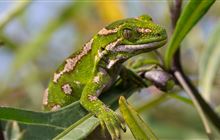Native Waitaha geckos released in Riccarton Bush
Archived content: This media release was accurate on the date of publication.
Introduction
Native geckos are set to find a new home in Riccarton Bush as part of a Lyttelton Port Company project supported by DOC.Date: 05 April 2019 Source: Lyttelton Port Company
On Monday April 8, Dr Graham Ussher and his team from RMA Ecology will be safely capturing Waitaha geckos from the Gollans Bay quarry to be released in Riccarton Bush on Tuesday afternoon April 9.
The eastern part of the Gollans Bay quarry has not been quarried before and is being used as part of the Lyttelton Port Company’s (LPC) Te Awaparahi Bay Reclamation project, creating a new container terminal to keep up with shipping demands.
Some of the area is habitat for New Zealand native Waitaha gecko, and LPC recently gained a Wildlife permit from DOC which sets out how the company must manage the effects on geckos.
Dr Ussher says the Waitaha are a small, nocturnal native gecko special to the central and southern South Island.
DOC regards the Waitaha geckos as a species that has reduced in numbers and distribution since the arrival of people and pest animals. They can live to be over 36 years old.
“That is why LPC is doing its best to capture and relocate the geckos to a safe place before the quarry is developed,” says Dr Ussher.
Last week Dr Ussher and LPC workers placed artificial habitats at key locations around the quarry to safely capture the geckos.
The team is aiming to catch all the geckos within the salvage area, which will include young lizards as well as adults which could be over 20 years old. The geckos will be released into tall native forest at Riccarton Bush.
“Although Riccarton Bush is different to the habitat from which they will be captured, we expect that they will do just fine – they are hard wired to use a range of habitats,” says Dr Ussher. “We are confident they will enjoy their new lodgings.”
Riccarton Bush was chosen because it has 7.8 hectares of established forest surrounded by a state-of-the-art pest and mammal-proof fence that keeps out predators such as rats and cats.
Before the arrival of humans, geckos would have been abundant and lived in a range of habitats from the sea shore to the forest canopy.
DOC’s Community Ranger Rachel Brown says a similar release of geckos was done in 2012 as part of the Sumner Road recovery project.
“Those geckos have been regularly seen by visitors and the Riccarton Bush Trust Ranger, so it's fantastic to see more of these native creatures safely relocated.”
All New Zealand geckos are fully protected, meaning they may only be handled under permit. It is illegal to deliberately harm them.
Ngāti Wheke are supporting the relocation of the geckos and will be attending the release to perform a karakia.
Background information
Reporters are welcome to attend the release of the geckos on Tuesday, April 9 at Riccarton Bush. We will be meeting ay 1.30 pm at Riccarton House for the release at 2 pm.
Waitaha geckos
- Scientific name: Woodworthia cf. brunnea
- Common name: Waitaha gecko
- Naming authority: Cope, 1869
- Bio status category: Indigenous (Endemic)
- NZ threat classification: Declining
Description:
- Brown, grey or olive with paler bands, blotches or stripes that are usually bright, and large blackish patches (especially on the intact tail).
- Usually with a narrow or broad pale stripe running from nostril to eye.
- Mouth lining pink, tongue pink with grey tip.
- Eye greenish, brown or yellow and often very large.
- Measures 53-80 mm from snout tip to vent.
- Specimens from coastal duneland habitat are distinctly smaller (53-68 mm between snout and vent) than those from adjacent forest/rock bluff environments (68-80 mm between snout and vent).
- Lifespan can exceed 36 years.
Contact
Phillipa Webb
Communications Advisor
Lyttelton Port Company
Phone: +64 27 373 0726
For media enquiries contact:
Email: media@doc.govt.nz

